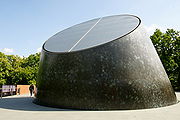
Peter Harrison Planetarium
Encyclopedia

Greenwich Park
Greenwich Park is a former hunting park in Greenwich and one of the largest single green spaces in south east London. One of the Royal Parks of London, and the first to be enclosed , it covers , and is part of the Greenwich World Heritage Site. It commands fine views over the River Thames, Isle of...
, London and is part of the National Maritime Museum
National Maritime Museum
The National Maritime Museum in Greenwich, England is the leading maritime museum of the United Kingdom and may be the largest museum of its kind in the world. The historic buildings forming part of the Maritime Greenwich World Heritage Site, it also incorporates the Royal Observatory, Greenwich,...
. It opened on May 25, 2007.
The planetarium uses Digistar 3
Digistar 3
Digistar 3 is a dome-based projection technology created by Evans & Sutherland - to offer audiences immersive entertainment and education experiences that integrate fulldome video, real time 3D computer graphics, and a digital planetarium facility...
software with blue, red and green lasers and grating light valve (GLV) technology to create a 4,000 pixel strip. This strip is swept to produce a 5,000 by 4,000 pixel image, refreshed 60 times per second. The image is projected through a fisheye lens
Fisheye lens
In photography, a fisheye lens is a wide-angle lens that takes in a broad, panoramic and hemispherical image. Originally developed for use in meteorology to study cloud formation and called "whole-sky lenses", fisheye lenses quickly became popular in general photography for their unique, distorted...
onto the dome of the planetarium.
The planetarium is housed inside a 45-ton bronze-clad truncated cone, tilted at 51.5o to the horizontal (the latitude of Greenwich), and stands parallel to (but 50 metres east of) the prime meridian
Prime Meridian
The Prime Meridian is the meridian at which the longitude is defined to be 0°.The Prime Meridian and its opposite the 180th meridian , which the International Date Line generally follows, form a great circle that divides the Earth into the Eastern and Western Hemispheres.An international...
. It was conceived under the then Director, Roy Clare CBE, as the centrepiece of the "Time and Space" project, a £17.7m re-development of the Royal Observatory, Greenwich
Royal Observatory, Greenwich
The Royal Observatory, Greenwich , in London, England played a major role in the history of astronomy and navigation, and is best known as the location of the prime meridian...
, and funded with a £3.25m grant from the Peter Harrison Foundation.
External links
- http://www.nmm.ac.uk/astronomy/planetarium.html

